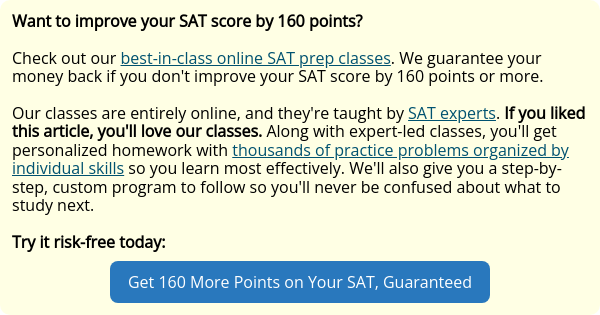
Every year about 500 students get a perfect score on the SAT. How many questions can you get wrong and still be among this elite group? Find out here in a complete breakdown of the Math and Reading and Writing sections across six official SAT practice tests.
How Is the SAT Scored?
To understand how many questions you can get wrong and still achieve a perfect 1600, you need to understand how the test is scored. I'll give a brief summary here, but if you're interested in more details about the scoring process, check out our guide on how to calculate SAT score.
The first order of business is to calculate your raw score. On the whole test, you receive one point for correct answers, and you receive zero points for a wrong answer and questions skipped. Since you’re not penalized for wrong answers, skipping or answering a question incorrectly results in the same score.
To calculate your raw Math section, you start by calculating the number of questions answered correctly (if you answered 50 correctly, your raw score is 50).
For the Reading and Writing section, you do the same exact thing: calculate the number of questions you answered correctly throughout the section (if you answered 60 correctly, your raw score is 60).
For both sections, each raw score is then converted into a scaled score — the exact conversion varies by test date. On the old paper-and-pencil versions of the SAT, your raw scores were converted to scaled scores based on testing dates and test difficulty. But there are a few other factors that will impact how your SAT is scored now that the SAT is digital.
One of the major changes made to the new and improved digital SAT is that it uses adaptive testing. Put simply, the test adapts to each test taker, offering more difficult questions to students performing strongly and less difficult questions to struggling students.
Here’s how it works: there are two sections on the SAT (SAT Reading and Writing and SAT Math), and each section is divided into two modules. Reading and Writing always comes first, so you’ll take the test in this order:
- Reading and Writing Module 1
- Reading and Writing Module 2
- Math Module 1
- Math Module 2
The questions in Module 1 will be an equal mix of easy, medium, and hard questions. After you finish all the questions in Reading and Writing Module 1, you’ll submit the entire module and move into Module 2. This is where the adaptive business comes into play; since the test is completely digital, it takes just a few seconds for the computer to assess your performance on the first module. It will (nearly instantaneously) assess your performance and configure a second module based on how well you performed in Module 1.
If you did really well, you’ll see more difficult questions—and if you didn’t do so well, you’ll see less difficult ones. This process will repeat again once you finish Math Module 1 and move into Math Module 2.
Adaptive testing makes scoring much more individualized, and each question on the test is weighted differently in the scoring process. More difficult questions will hold more weight when answered correctly, and less weight when answered incorrectly. The same goes for easier questions—you can expect to earn less credit when you answer them correctly.
This basically means that you can afford to miss more questions if you answer more difficult questions correctly. Likewise, if you don’t perform well on Module 1 and Module 2 is a mix of easier questions, you won’t be able to miss very many of them.
We also know that there is now a scaled score range instead of just one number or score. The College Board explains that this range includes scores you might expect if you took the SAT multiple times on different days.
Lastly, since the test is completely digital, scoring is a quick, computerized process. This also goes for the most recent practice tests. The College Board has six official, digital practice tests available through Bluebook that are scored automatically. They’ve really taken the headache out of scoring practice tests!
There are also six official, linear (non-adaptive) practice tests available, but they’re scored a little differently since they don’t use adaptive testing. One of the major things to notice is that there are more questions on the linear practice tests than there are on the digital ones. There are also a few differences in each of the test's conversion charts (to account for question difficulty).
We’ll break down one of these linear practice tests to show you how raw scores are converted to scaled score ranges. Here’s an example chart SAT Practice Test 5:

Let's go through how the scoring works for each section in a bit more depth. For Math, the raw to scaled score conversion is very simple. Let’s say you miss two questions (you got 52 correct out of 54 questions); your raw score will be a 52. You then find the corresponding scaled score range for Math on the chart, which is 780-800. You could expect your Math section score to be between this range if you were to take SAT Math multiple times on different days.
This process works the exact same way for Reading and Writing. If you missed three questions in Reading and Writing (got 63 out of 66 correct), your raw score would be 63. The corresponding scaled score range for Reading and Writing on the chart is 760-780, so you could expect to score somewhere in that range on SAT Reading and Writing.
Exactly How Many Questions Can You Get Wrong or Skip and Still Get a 1600?
Since the scores on the individual sections are simply added together to create your composite SAT score range, you need to score 800 on the two sections (Math and Reading and Writing) to get a score of 1600.
Typically, to get an 800 in Math, you cannot miss any questions because you need to get a raw score of 58 (out of 58 questions). Occasionally, an SAT will allow you to get one wrong answer in Math as you can see on Tests 4 and 8. However, I would not count on that, as it is not the norm. If you're aiming for 1600, strive for perfection in Math.
Typically, to get an 800 in Math, you would not want to miss any questions so you could be absolutely sure to get a perfect score. But with the new digital SAT, adaptive testing makes it possible to get a perfect score even if you miss multiple questions on each section of the test. This is reflected in the practice test above—notice that a raw score of 51-54 could potentially earn you a perfect 800 in SAT Math. The trick to missing questions and still earning a perfect 1600 on the SAT is answering all of the more difficult questions correctly. Since these ranges estimate what you might score across different test dates, though, it’s still a good idea to strive for perfection on SAT Math.
Like with Math, the only way to be 100% sure to get an 800 in Reading and Writing is to get every single question correct in the section. For our practice test, a raw score of 65-66 could potentially earn a perfect 800 in SAT Reading and Writing, so that’s fewer missed questions than in the Math section. However, it’s a score range for a reason—you shouldn’t expect to earn the ‘upper’ score exclusively.
Overall, on the SAT, you should aim to get no questions wrong if you want a perfect score. This is no easy feat, but it is possible. After all, about 500 students do it each year!
What Does This Mean If You're Trying to Get a 1600?
You need to make sure that you can finish the entire test in the allotted time since you cannot afford to skip or miss any questions.
For Math, you need to be basically perfect. The new adaptive testing feature of the digital SAT means that more difficult questions hold more weight than easier ones, but there’s no way to know which questions are the difficult ones until you get your score back. To be safe, you need to plan on answering all of the questions right if you want an 800.
For Reading and Writing, you also need to be basically perfect. On the official practice test above we found that a raw score of 65-66 was needed to earn a perfect 800, which means missing one single question in this section might earn you an 800—but it might not. It all depends on the day you take the test and the difficulty levels of the questions you get correct. When in doubt, plan on getting zero questions wrong to get a perfect score.
The digital SAT is still very new, and we’ll learn more about scoring and the weight of question types throughout 2024. Come back for more updates and specific information about how adaptive testing affects SAT scoring!
What's Next?
Trying to get a perfect SAT score? You should check out our SAT study guide.
Taking the SAT soon and need to improve your score in a hurry? Read our SAT cramming guide.
Aiming for the Ivy League? Read our guide to getting in!











